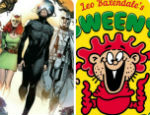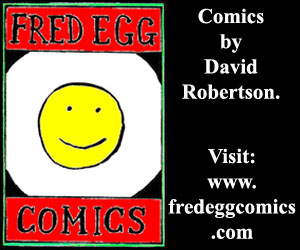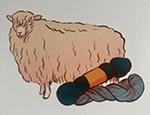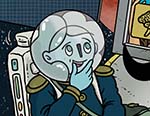Darryl Cunningham’s use of the comic strip form in Science Tales as an investigative journalistic tool to bust some of the popular myths about contemporary scientific issues was one of the highlights of 2012’s U.K. graphic novel publishing schedule and a worthy British Comics Awards 2012 nominee. Updated with new material, the latest edition of the book from Myriad Editions includes an additional chapter wherein the author tackles the controversial subject of hydraulic fracturing, or “fracking” as it has become commonly referred to in the press.
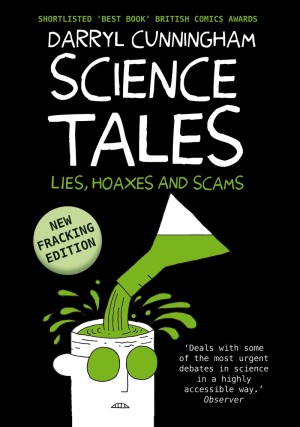 This new material is an excellent example of Cunningham’s approach to subject matter that many of us, no doubt, would simply switch off from or hurriedly turn the page when presented in other media. His ability to break down relatively complex issues into easily digestible and compelling narratives without ever compromising the points he makes is quite remarkable. For that reason this week we’re re-running below the following review of the first edition of Science Tales which was originally published on Broken Frontier in April 2012:
This new material is an excellent example of Cunningham’s approach to subject matter that many of us, no doubt, would simply switch off from or hurriedly turn the page when presented in other media. His ability to break down relatively complex issues into easily digestible and compelling narratives without ever compromising the points he makes is quite remarkable. For that reason this week we’re re-running below the following review of the first edition of Science Tales which was originally published on Broken Frontier in April 2012:
Collected from his popular webcomics series, Science Tales is Darryl Cunningham’s graphic novel investigation into some of the most passionately contested hot topics of popular science. With a mission statement to take a rationalist approach to subjects like climate change, evolution, and homeopathy, Cunningham looks to bust the myths, debunk the illogical contentions and dismiss the conspiracy theories that have grown up around so many areas of scientific thought.
A couple of years back Daryl Cunningham’s Psychiatric Tales was published by Blank Slate Books to great critical acclaim. It was a book that similarly focused on, and exposed, some of the ignorant beliefs surrounding mental illness, and was written from the personal perspective of both a health care professional and someone who had experienced their own struggle with a depressive condition.
In Science Tales, Cunningham uses a similar storytelling structure to impart his analysis and examine the issues raised. Under the broad umbrella of scientific inquiry the subjects Cunningham tackles are diverse and cover areas that represent differing levels of controversy; his argument for the veracity of the moon landings, for example, may anger those intent on seeing conspiracies at every turn but, in comparison to the intense passions that the case for evolution over creationism may provoke in the religiously-minded, it pales and enters into the realms of a pub argument in comparison.
Cunningham projects a quietly authoritative voice throughout. As the narrator and host for each chapter he is confrontational yet balanced; unflinching in his condemnation of the irrational and the unsupportable without ever lapsing into belligerence. Each graphic essay provides a digestible analysis of the topic and an easily grasped and reasoned refutation of the counter-arguments to scientific procedure and exploration.
Artistically, Cunningham’s clean lines and his deceptively simple cartooning style perfectly complement the clarity inherent in the delivery of his carefully considered points. His occasional insertion of photographic imagery is wholly effective in grounding the book and reminding the readers of the reality of some of the more absurd claims of the science deniers he is railing against. It’s also a very poignant technique in places: in the chapter on chiropractic therapy, for example, to suddenly see staring up at the reader the real world face of the mother of a young woman killed by the incompetence of a chiropractor is a jolting and sobering experience, and a reminder of the seriousness of the points Cunningham is making.
What almost interests me more about Science Tales than its content is Cunningham’s ability as a graphic communicator. He has a keen understanding of how comics as a form are the great disseminator of relatively complex ideas, and a profound aptitude for exploiting their very individual structure and unique narrative potential to inform and educate. Clearly scrupulously researched, for those wishing to investigate further there’s also a list of references and further reading at the back of the book.
From electroconvulsive therapy to the MMR vaccine, Cunningham manages to deftly précis the salient points of each chapter’s discussion in an entertaining, engaging and sometimes slyly witty way. Science Tales manages to be somehow simultaneously both succinct and substantive, and a fierce and intelligent promoter of the scientific process over blind superstition and baseless supposition. Myriad’s already formidable and growing reputation for bringing us some of the most thought-provoking and atypical graphic novels on the shelves has just been strengthened a little bit more.
Darryl Cunningham (w/a), Myriad Editions, £11.99, 7th June 2013
Science Tales is published in the U.S. by Abram Comic Arts under the title How to Fake a Moon Landing.






